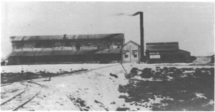Crystal Salt Company light railway in Port Augusta
| Crystal Salt Company light railway in Port Augusta |
|||||||||||||||||||||||||
|---|---|---|---|---|---|---|---|---|---|---|---|---|---|---|---|---|---|---|---|---|---|---|---|---|---|
|
Decauville steam locomotive with tipping platforms
| |||||||||||||||||||||||||
| Route length: | 1.7 km | ||||||||||||||||||||||||
| Gauge : | 610 mm ( 2 foot track ) | ||||||||||||||||||||||||
|
|||||||||||||||||||||||||
The Crystal Salt Company light railroad in Port Augusta was a 1.7 km long narrow-gauge railway with a gauge of 610 mm (2 feet ), which ran eight kilometers north of Port Augusta West from 1915 to 1921 with a Decauville steam locomotive acquired second-hand and then up to 1935 was operated with two rail tractors.
Route
From the crystallization basin, a 900 meter long straight section led northeast to the salt factory and its salt storage facility.
From the warehouse of the factory a 800 m long section to the northeast led on a wooden trestle bridge over the Spencer Gulf and then through a railway embankment on the Watt to a transfer station at the CR - standard gauge route Port Augusta - Kalgoorlie . At the reloading point there was an alternate connection point for the standard-gauge railway, a ramp-shaped platform and a goods shed.
Track construction
The section from the 45 x 60 m crystallization basin to the salt factory was laid from lightweight, fixed, narrow-gauge railway tracks on hardwood sleepers weighing 10 kg / m (20 pounds / yard) and 7 kg / m (14 pounds / yard).
The section of the transfer station to the salt plant consisted of 218 prefabricated Field track - track panels with a weight per meter of 20 kg / m (40 lbs / yard) and a length of 6700 mm. There were also 70 track sections in different lengths from 4880 mm to 6100 mm.
business

|

|
|
|
Decauville steam locomotive with tipping platforms , around 1920
|
Crystal Salt Company's salt factory, around 1920
|
The Crystal Salt Company went bankrupt in 1921 due to transportation problems. At the latest after the company was taken over by Ocean Salt in October 1921, a light Purcell or Caldwell-Vale rail tractor and a heavy Fordson rail tractor were used.
From the crystallization basin, the salt was transported to the factory in 20 tilting lanes with a capacity of 0.57 m³ (¾ cubic yard ) and 0.38 m³ (½ cubic yard). There were also several 914 mm wide and 1372 mm long (3 × 4½ feet ) flat carts .
On the route from the factory to the transfer station, the packaged into bags salt to several 1295 mm wide and 6110 mm long (4¼ x 20 feet) was bogie - flatcar transported.
In 1935, regular operations were stopped due to sand drifts, among other things. The points at the alternative junction were dismantled in May 1937. Some of the rail vehicles and some of the rails on the section between the crystallization basins and the factory were sold in 1941, but the route to the transshipment point remained in place until April 15, 1955.
Web links
Individual evidence
- ^ A b c Norm Houghton: Port Augusta: Crystal Salt Company. In: Light Railways, No. 115, January 1992, Cheetham Chronicles Part II. Early South Australian operations. Pp. 7-11.
- ^ A b c John Browning: More on Crystal Salt. In: Light Railways, No. 249, June 2016. pp. 19-21.
Coordinates: 32 ° 26 ′ 11.3 " S , 137 ° 45 ′ 16.6" O


